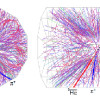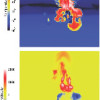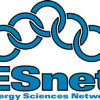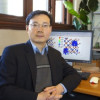News Archive
NERSC Helps Shed Light on the Nature of Antimatter
Using the National Energy Research Scientific Computing Center's (NERSC) Parallel Distributed Systems Facility (PDSF) and the Brookhaven National Laboratory’s Relativistic Heavy Ion Collider (RHIC), physicists have detected and confirmed the first-ever antimatter hypernucleus, called "antihypertriton." Read More »
Baby Brutes
Astronomers have in recent years been surprised to find hulking brutes among the baby galaxies of the early Universe. Studded with bright, giant clumps of rapidly forming stars, these big galaxies hail from a time when the cosmos was less than 4 billion years old, yet each contains about the mass of a modern Milky Way, which took 10 billion years to form. Read More »
Exploring Cloud Computing for DOE's Scientific Mission
Cloud computing is gaining traction in the commercial world, with companies like Amazon, Google, and Yahoo offering pay-to-play cycles to help organizations meet cyclical demands for extra computing power. But can such an approach also meet the computing and data storage demands of the nation's scientific community? Read More »
ESnet Collaborates with Dutch SURFnet, Scandinavian NORDUnet to Create Network Research Framework
BERKELEY, Calif., AMSTERDAM, the Netherlands, COPENHAGEN, Denmark—Energy Sciences Network (ESnet), the high speed network connecting thousands of Department of Energy scientists and managed by Lawrence Berkeley National Laboratory, is embarking on a cooperative research effort with SURFnet (www.surfnet.nl), the national computer network for higher education and research in the Netherlands, and Scandinavian research network NORDUnet (www.nordu.net) to explore potential synergies between the unique technical knowledge and expertise that each organization has to offer. Read More »
Historic Sudbury Neutrino Observatory Data, Carried by ESnet, Lives on at NERSC
Tunneled 6,800 feet underground in Canada's Vale Inco Creighton mine, the Sudbury Neutrino Observatory (SNO) was designed to detect neutrinos produced by fusion reactions in the Sun. Although the observatory officially "switched off" in August 2006, a copy of all the data generated for and by the experiment will live on at the National Energy Research Scientific Computing Center (NERSC). Read More »
Berkeley Lab Receives New Grants to Research Complex Systems
As the nation and the world become increasingly dependent on complex networks ranging from the Internet to electrical grids and centralized computing systems, understanding how these systems operate is of paramount importance. To address this issue, researchers in Lawrence Berkeley National Laboratory's Computational Research Division (CRD) will lead two projects funded at a total of $3.5M million under a U.S. Department of Energy (DOE) program to study the mathematical challenges involved in improving our understanding of complex, interconnected systems such as computer networks. Read More »
A Computational Science Approach for Analyzing Culture
Just as photography revolutionized the study of art by allowing millions of people all over the world to scrutinize sculptures and paintings outside of museums, researchers from the Software Studies Initiative at the University of California at San Diego (UCSD) believe that a new paradigm called cultural analytics will drastically change the study of culture by allowing people to quantify evolving trends across time and countries. Read More »
Researchers Receive INCITE Awards Aimed at Restoring Carbon Balance
As humans emit more carbon into the atmosphere than the planet's natural processes are able to remove, the Earth's carbon cycle is increasingly out of balance. In an effort to restore the carbon balance, researchers in the Lawrence Berkeley National Laboratory's (Berkeley Lab) Computational Research Division (CRD) have developed computational methods to explore the viability of carbon-neutral technologies, like nano solar cells and near-zero emission combustion devices. Read More »
Madly Mapping the Universe
To map our home planet, Google Earth depends mostly on satellite imagery for land surfaces and sonar imagery for the sea floor. Maps of the Universe likewise depend on different kinds of detectors for different kinds of features. Maps of the cosmic microwave background (CMB), for example, depend on measuring minute differences in the temperature of the sky. Read More »
Mismatched alloys are a good match for thermoelectrics
Employing some of the world’s most powerful supercomputers, scientists at Lawrence Berkeley National Laboratory have shown that mismatched alloys are a good match for the future development of high performance thermoelectric devices. Thermoelectrics hold enormous potential for green energy production because of their ability to convert heat into electricity. Read More »







 Instagram
Instagram YouTube
YouTube








